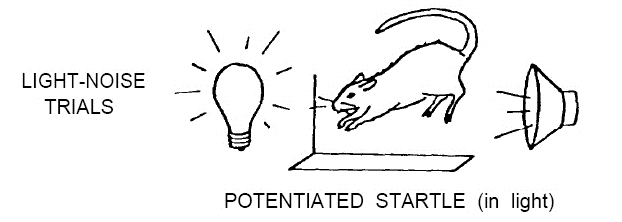Fear Conditioning: Integrated Behavior
Fear Conditioning
IX. Integration of Fear Conditioning
A. Acoustic Startle Circuit
1. Loud sudden Sound
2. Ear
a. Cochlear Root Neurons (CRN) in VIIIth nerve
i. Glu: Carry Acoustic information
(1) not for hearing purposes
(a) hearing: not necessary for startle
i) not missing
ii) affects startle via PPI
3. Reticular caudal Pontine nucleus (PnC = pontis caudalis reticularis)
a. AMPA/NMDA
b. can be potentiated by additional Glu inputs
i. from CeA, Deep SC, reticular nucleus, and PAG
4. Spinal motor neurons: ACh
a. PnC potentiation can à ñ recuitment of motor neuons
5. muscles
a. Nicotinic Receptors
6. Jump
B. Fast Fear Circuit
1. Foot Shock
2. Nociceptors
a. bare sensory receptors in the skin of the foot
i. soma in DRG (dorsal root ganglion)
b. terminals in the dorsal horn (gray) of the spinal cord
i. Glu à AMPA/NMDA
ii. some may colocalize SP
3. Nociceptive information to Posterior Intralaminar Nucleus (PIN)
a. Glu à AMPA/NMDA
4. Basolateral Amygdala
5. BLA Glu à AMPA/NMDA Central Amygdala
6. CeA Glu à AMPA/NMDA PnC
a. CRF too?
C. Slower Fear Cicuit - modulated
1. Foot shock à Nociceptors à Spinal Dorsal horn à
2. decussation à spinothalamic tract in anteriolateral column à Thalamus
3. Thalamic PIN + VPNGluà AMPA/NMDAPosterior Insular Cortex (PIC)
a. Thalamic nociceptive neurons:
VPNGlu à AMPA/NMDASomatosensory CortexGlu à AMPA/NMDAPIC
4. PIC Gluà AMPA/NMDA LA à BLA
D. Visual Conditioned Stimulus Circuit
1. light presented just before/during foot shock
2. Eye
a. Retina Glu Þ AMPA/NMDA thalamic LGN
b. LGNGlu Þ AMPA/NMDAvisual 1o ctx Þ temporal ctx Þ perirhinal ctx
i. temporal ctxGlu Þ AMPA/NMDALAGlu Þ AMPA/NMDABLA
ii. perirhinal ctxGlu Þ AMPA/NMDALA Þ AMPA/NMDABLA
c. Retina Glu Þ AMPA/NMDA thalamic LPN
i. LPNGlu Þ AMPA/NMDAvisual 1o ctx / temporal ctx
/ perirhinal ctx and LA
E. Fear Learning Circuit
1. light (1. temporal cortex/ 2. perirhinal cortex/ 3. LPN)
+ shock (4. PIN / 5. PIC) Þ LA
2. light LAGlu signals + painGlu siganals converge LAÞ BLA neuroplasticity
a. Acquisition
i. Glu potentiation
1) Glu Þ NMDA with GluN2B (NR2B) Þ MEK/ERK
2) BDNF - TrKB Þ PI3K; ERK Þ nucleus
a) CREB Þ CRE
b. Consolidation
i. ò BLA gephyrin Þ ò GABAA
1) ò GABAA Þ ñ LTP
a) ñ BDNF - TrKB
F. Expression (Light + Loud sudden Sound = Conditioned Fear + Startle)
1. Þ ñ BLA AMPA Þ ñ NMDA with GluN2A (NR2A)
2. BLA Þ ñ MeA AMPA Þ ñ NMDA with GluN2A
a. MeAGlu/Enk/SP Þ ñ AMPA/NMDA/m/NK1VMHEnk/SP Þ ñ m/NK1PAG
3. BLA Þ ñ CeA AMPA Þ ñ NMDA with GluN2A
a. CeA Glu Þ ñ PnC AMPA/NMDA
4. Convergence of CRN, PAG, CeA Þ PnC
a. Glu potentiation
i. CRF from longer term stress Þ ñ PnC Glu potentiation
ii. Þ ñ#neurons firing + rate
b. ñññ PnC Þ ñññspinal cord ventral horn
motor neuron ACh
c. Þ ñ ñ ñ quadriceps femoris + gastrocnemius muscles
d. ñ ñ ñ jump
